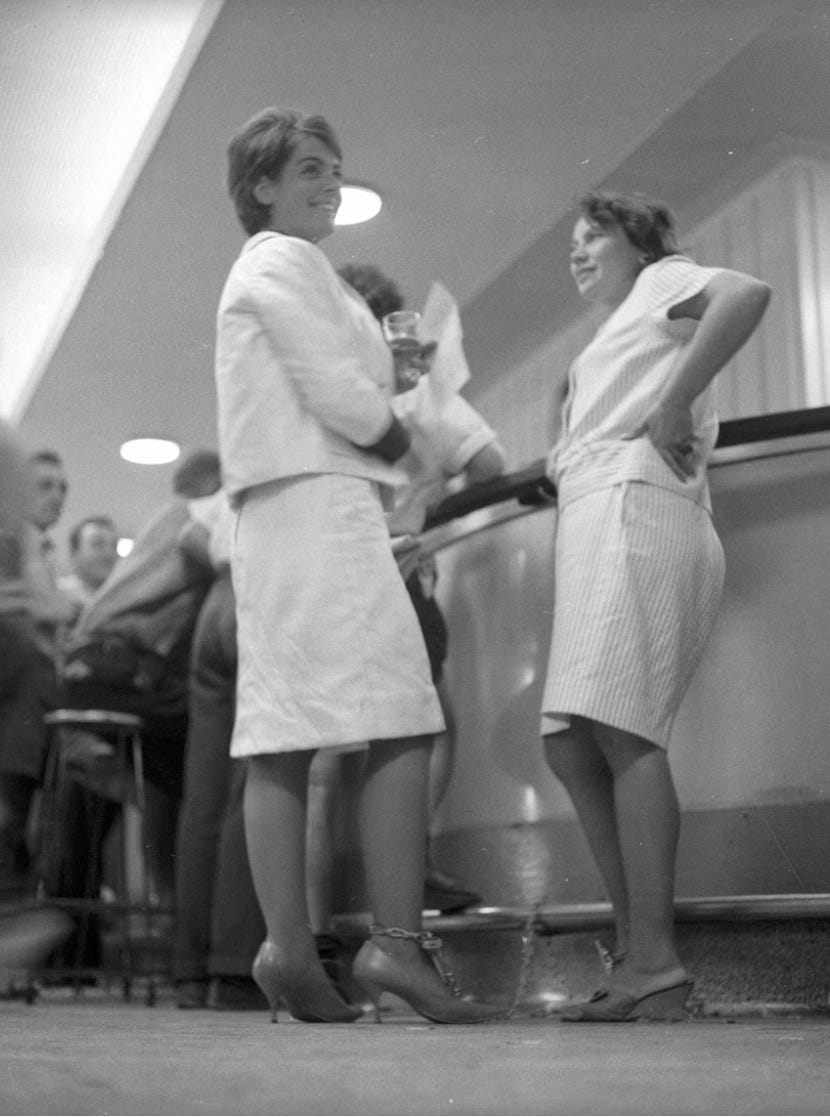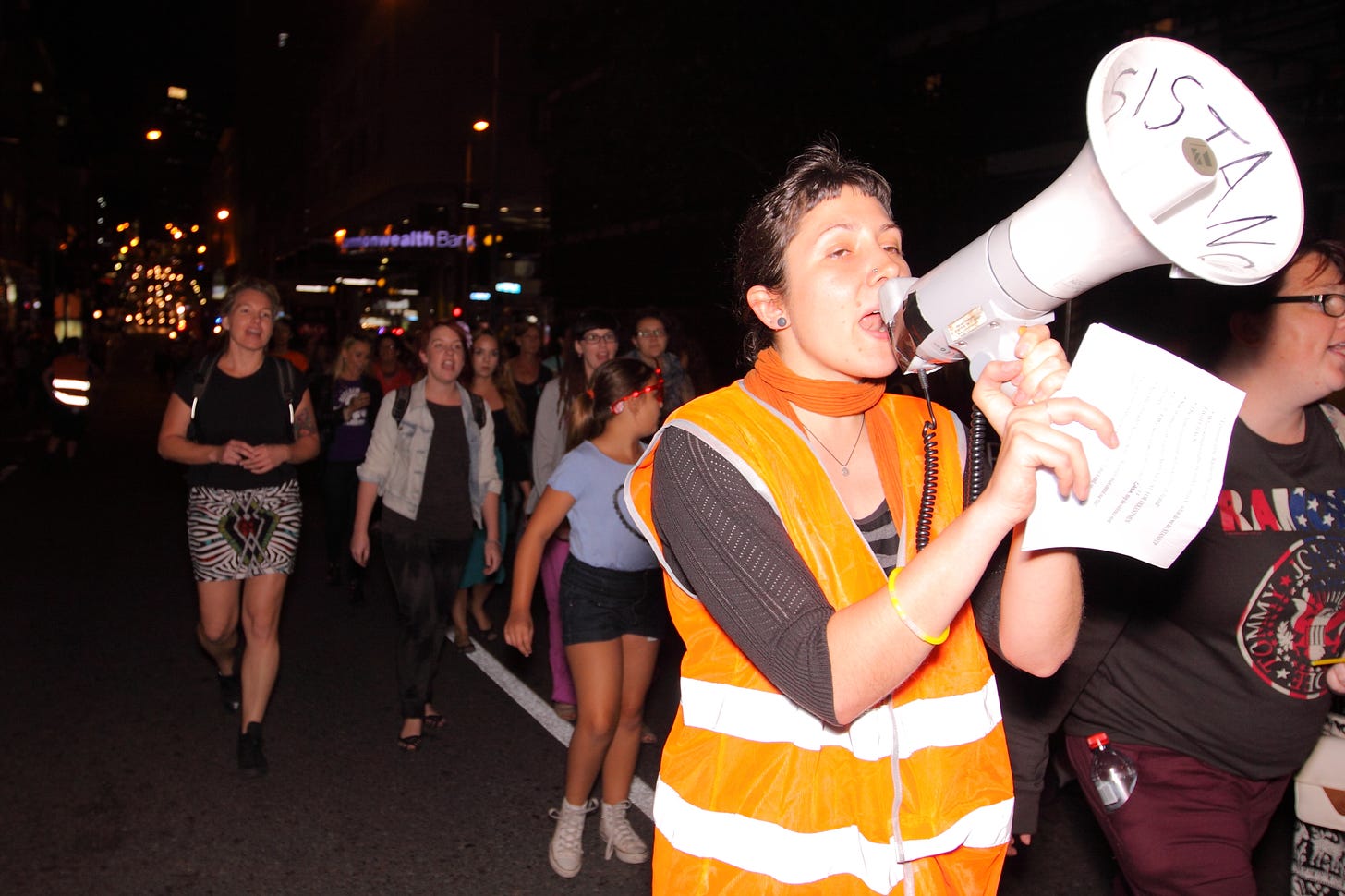There has been much media talk this week of the deaths of famous actors: Alain Delon, who was arguably to the right of Marine Le Pen and so will not be missed by anyone even vaguely to the left of her; and the wonderful Gena Rowlands, who will surely be missed a great deal.
But there is someone else whom feminists in Australia will surely miss more, yet we have hardly seen any news of her passing, outside the Australian Broadcasting Corporation and The Brisbane Times, with relays on social media. We have found out via those sources in the last 24 hours that early “second wave” feminist activist Merle Thornton died on 16 August. She first made headlines in 1965 when she and a friend Rosalie Bogner chained their ankles to the foot rail running along the bar at the Regatta Hotel in the Brisbane suburb of Toowong, in protest against a bartender’s refusal to serve them. (Women were not allowed to drink in public bars in Queensland hotels until 1970.) She told the media at the time that although there were many more important issues for women (such as equal pay, a battle we are still fighting), this was one where they thought they could make a quick impact. Well, given what a slow boat the Law is (as a servant of entrenched relations of ruling), it is arguable that five years is relatively quick to turn that Boat of Misogyny even a nano-degree from its course. Thornton also founded the Equal Opportunities for Women association to campaign for equal workplace rights (which included battling multiple discriminations against married women and women with children), as well as what is credited with being the first women’s studies course in Australia, at the University of Queensland in 1972.
I was privileged to meet Merle at a 2004 conference held in Brisbane to commemorate the 20th anniversary of the Sex Discrimination Act (SDA), where both Merle and I were among the featured speakers. That was back in the day when the word “woman” posed no definitional challenges for anyone, for it was collectively understood as a question of material and social reality (however one interpreted that reality) rather than one of individual fantasised identity. The Sex Discrimination Act was thus also understood as pertaining to women as a sex class.
Ah, them wuz the days. We had national feminist conferences where academics and activists (many of us were both) interacted and debated, and our commonality across our differences was that women were not treated well and that, to summarise it bluntly, men were the problem. Whether we called it patriarachy or masculinity or male domination or male violence or male entitlement or even something with “gender” in its name (yes, already back then), we all pretty much understood what it was. Where we diverged was on how bad it was, whether or how it interacted with other factors such as race, class, capitalism and so on—and whether it was all part of the same system or a series of separate but intersecting systems. And most importantly, what were the best strategies for effecting improvements in women’s lives.
We are still debating all of those things, but today the debate is more than a little complicated, first, by the politics of gender identity. (I always knew that using “gender” as a euphemism for either women or male domination was a really, really bad idea because look what it has led to. But that is a conversation for another day.) Second, we are seeing more and more our political class appearing to take seriously the many forms of misogyny and its impacts on women, yet at the same time the misogyny is taking on new forms of expression (also to do with “gender”, of course) and its impacts on women’s lives are, paradoxically in the light of the political attention being paid to us now, either not abating or are increasing.
Much in the news of late has been the political and material problem of male violence against women, usually framed as domestic violence or family violence or intimate partner violence. If I have to choose among these frames I prefer the last one because it is more accurate: most women are killed by men known to them. (Incidentally, so are most trans-identified males. Not by women. Not by anything any of us say or do. By men. More often than not either pimps or drug dealers. Just for the record.)
Over the many decades of public consciousness-raising, thanks to dogged feminist campaigning, writing, and just plain SHOUTING when nothing else got any attention from the political class, male violence against women (MVAW) is now routinely foregrounded by governments as a societal and political problem in need of urgent action. Yet it has been “urgent” for fifty years: “family violence” was first defined in the Family Law Act of 1975, which provided for the establishment of the Family Court. Three years later, Reclaim the Night marches started in Australia.
Fifty years.
Fifteen of those years passed before government agencies started keeping statistics on the victims of violent crime (which is better than the UK, which has only recently started counting dead women after feminists had been doing it for years). And another six passed before the Australian Bureau of Statistics conducted the first national comprehensive survey on violence against women (Women’s Safety Survey, 1996). In 1997 the then Howard government brought in Partnerships Against Domestic Violence (PADV) to fund various projects to address MVAW. Among the many criticisms of the operation of PADV (including lack of thorough consultation with autonomous women’s organisations already working in the sector about how the funds should be spent), was that of the derailing of “unspent funds relating to the Women’s programmes” to finance the government’s notorious (and much-mocked) post-9/11 “Be Alert, but Not Alarmed” anti-terrorism fridge magnet campaign, which cost over AU$10 million.1
And so it went on: governments pledging to address this grave societal problem as a matter of urgency, funding committed, surveys conducted. Many, many women working hard, against discouraging odds, to support women and lobby governments. One of them, Rosie Batty, whose son Luke was murdered by her violent ex, was even awarded Australian of the Year in 2015. Yet, over the last three years the rate of murder of women by current or former intimate partners has spiked: in the first four months of this year, 33 women, or roughly two per week, were murdered in Australia.
That statistic, and the actions of Joel Cauchi on 13 April, who stabbed eighteen people, six of them fatally, in a Bondi Junction shopping mall (security video footage indicates he was specifically targeting women), led to massive demonstrations in Australian cities and towns in the last weekend in April. They also led to the announcement by Australian Attorney-General Mark Dreyfus of a range of new governmental measures to address MVAW. Speaking at a Family Violence Symposium at the Federal Circuit Court on 19 April, Dreyfus said that
One death of a woman at the hands of a man is one too many. One death a week is an epidemic. It must end. We have a crisis of male violence in Australia. … It is a scourge in our society and it must end. To create lasting change, women cannot be expected to solve violence against women alone. It’s time for men to step up …We must focus on prevention, working together and finding new ways of doing things.
Fifty years.
That’s a helluva long-lasting epidemic. Imagine fifty years of COVID-19. Actually no, we can’t, because huge money, skills and time were put almost immediately to developing effective remedies and prevention. (Even so, the larger problem of how COVID-19 jumped from non-domestic animal to human in the first place, which is the most likely scenario, has been left largely unaddressed. Let’s just think about that for a moment.)
This week, Domestic, Family and Sexual Violence Commissioner Micaela Cronin (yes we have one of those now, since 2022) gave her inaugural address to the National Press Club. In that address, she criticised the National Plan (yes, another one) to End Violence against Women and Children for focusing overmuch on women and not enough on men’s responsibility. Cronin suggested that “what we need is for the community to take as seriously threats of domestic, family and sexual violence as they take terrorist threats, act on them as urgently”. (Sure, but maybe no fridge magnets this time.)
This comparison between MVAW and terrorism (or extremism) is both new and not new. Certainly not new for feminists. In 1989 US feminist Robin Morgan published her book The Demon Lover: On the Sexuality of Terrorism, in which she argued that the “the terrorist is the logical incarnation of patriarchal politics in a technological world” (p. 33, italics in the original).2 In her new introduction to the second edition published post-9/11, she wrote about the various forms of new anxieties and fears experienced by the US populace after the 9/11 attacks, observing that
such symptoms aren’t new to everyone in the U.S. These are exact descriptions of the rape survivor’s reality; the abused child’s experience. A terrified man isn’t as much a cultural fixture as a terrified woman or cowering child for a reason: the latter are familiar images. The spectrum of violence and terror ranges all the way from the fist in the face to the nuclear bomb. It is the same spectrum, differing in degree but not in kind. We can no longer afford to ignore it, dismiss it or deal with it piecemeal (p. xvii, italics in original).3
No, not new. But the political class has suddenly leapt upon this analogy as a new strategy to try to get MVAW taken more seriously. In the UK, the newly elected Labour government’s Home Secretary Yvette Cooper announced that the Home Office would treat extreme misogyny as a form of extremism under its counter-extremism strategy. The first thing that came into my head on reading this was “You mean, like extreme ironing?”. Hence the title of this post. Although admittedly glib, that analogy is not entirely whimsical: various studies have shown links between male participation (or even watching) of the sorts of sports favoured by men and male aggression, including a correlation with VAW. In Demon Lover, Robin Morgan discusses the figure of the Deadly Hero and the normalisation of male violence, her take on Hannah Arendt’s “banality of evil” being the banality of patriarchy. Men behaving badly is so normalised that it is even often treated with amusement of the boys-will-be-boys kind (to the point of becoming the title of a popular UK sitcom in the 1990s). Men behaving extremely badly becomes, according to such logic, something akin to an extreme sport.
Similar thinking is occurring in Australia. A study by Sara Meger, Melissa Johnston and Yolanda Riveros-Mora, published by the University of Melbourne in June this year, found that “racist and misogynistic attitudes are strong and significant causal influences” on the expression of “sympathies for violent extremism”, regardless of ideological or religious affiliation. This, they argue, not only points to a need to consider these factors in strategies to combat violent extremism but “also shows the urgent need for a holistic approach to redressing racist and misogynistic attitudes as a matter of security urgency”.
The problem with positing concepts such as extreme misogyny and its links to national security emergencies is that it sets up a distinction between the extreme and the non-extreme, and in doing so, does nothing to address your common garden misogyny: that banal evil that is the male fist—actual or metaphorical—in every woman’s face. Or as Julie Bindel put it in a recent commentary, talking about “extreme misogyny” is “like saying something has an ‘effervescent fizz’.” Bindel argues that setting up a two-tier approach to MVAW “will only end up minimising the borderline cases, and raising the bar for what is reported”. The issue is more that existing laws against violence against women need to be applied properly and for all institutions tasked with doing so to take MVAW seriously. Indeed.
The misogyny that kept Merle Thornton from enjoying a beer in a pub or staying in the workplace when she married and had children is the same misogyny that led to the horrific murders Hannah Clarke and her children in Brisbane in 2020 or of Molly Ticehurst in Forbes, NSW, in 2024, or of countless other women who were not taken seriously by police and the courts when they sought protection against violent men. “It is the same spectrum, differing in degree but not in kind.”
And it is the same misogyny that women in our parliaments, whether as employees or elected representatives, are battling with on a daily basis. (This week, the Federal government has introduced a bill to establish an Independent Parliamentary Standards Commission, which would protect employees but not elected representatives who have denounced misogynist bullying in the House.) This is the price that men exact from women for the workplace equality that Thornton campaigned for. Every advance, every single advance, achieved by women in society comes at a price. Every time, every time, a woman says “no” to a misogynist male she is punished for it. Every single time.
Fifty years.
That is quite long enough.
Winter, Bronwyn. 2007. “Preemptive Fridge Magnets and Other Weapons of Masculinist Destruction: The Rhetoric and Reality of ‘Safeguarding Australia’.” Signs: Journal of Women in Culture and Society 33(1): 25-51. Themed issue on “War and Terror”.
Morgan, Robin. [1989]1990. The Demon Lover: On the Sexuality of Terrorism. New York & London: W. W. Norton.
Morgan, Robin. 2001. The Demon Lover: The Roots of Terrorism. London: Piatkus.






When a policy has been around that long and the problem persists it it a clear sign that it doesn't work. I think part of the problem is that people are assigning fault based not upon objective evidence of where the cause is, but instead attributing causality to align with their ideological leanings. You can only solve a problem by removing its causes - and you cant do that if these causes are misidentified to push extraneous agendas.
Toxic masculinity and rape culture are just labels for the same thing: men behaving badly toward women (and each other to an extent). And the campaigns against violence are of null value since the very men who are the problem are precisely the ones who will not listen/change. An unfortunate truth is that men will not listen to women - male behaviour will only change from other men diminishing the status of abusers, particularly during the developmental years.
I've come up with a theory about the developmental roots of violent male behaviour, and I'm hoping to publish a full article about it on S. The main idea is that male behavioural norms arise during the adolescent years during a period if intense competition for status and dominance hierarchies. Boys compete with each other to establish their masculine credentials through symbolic "adult-like" behaviours like fighting, boozing, driving (fast/drunk), and particularly sexual success with women. This process produces two extremes - those who go overboard with it and problematic norms stay with them for life; and those who fail and develop a foundational resentment toward women for their failure: the misogynist/incel dichotomy. It is clear to me these two extremes are opposite ends of the same spectrum.
I am not an academic in the field mind you, my view is based on observation and life experiences. The root of this problem lies among men and can only be solved within their milieu by socialising boys away from such patterns. Its a generational project, and made much more difficult in this era due to the neoliberal economic norms which have just stoked the ultracompetitive environment.